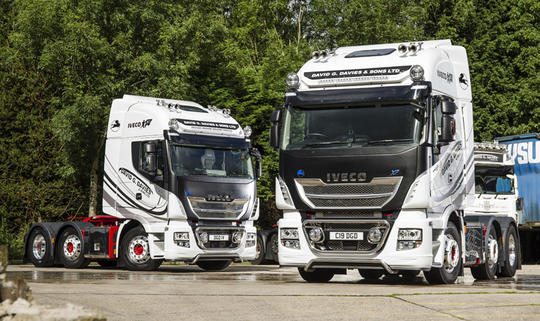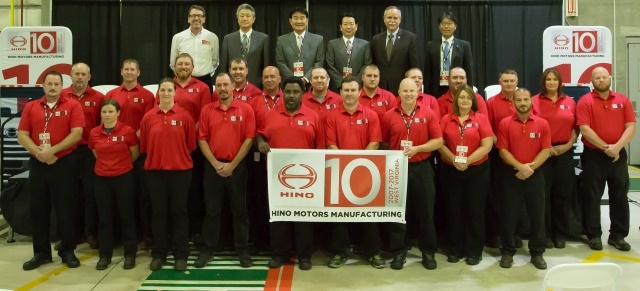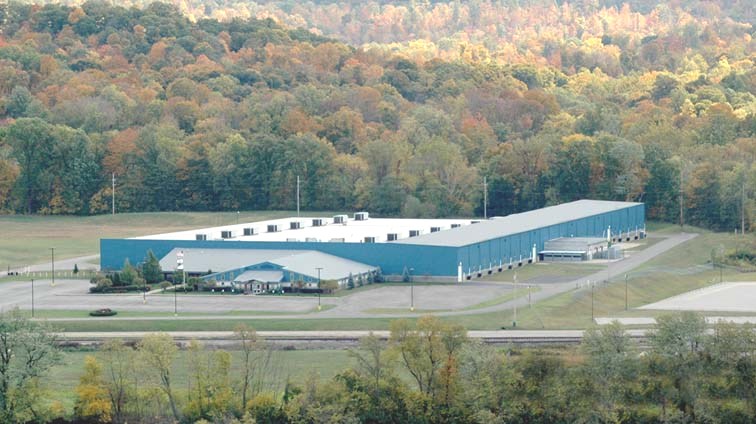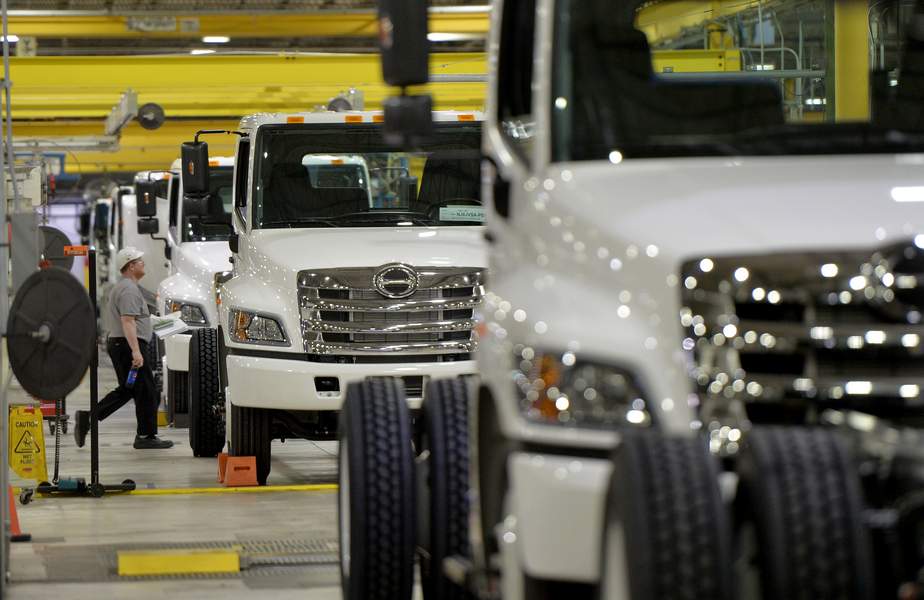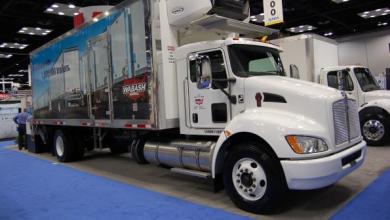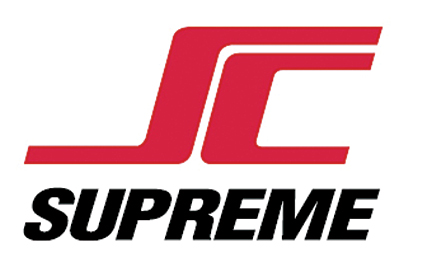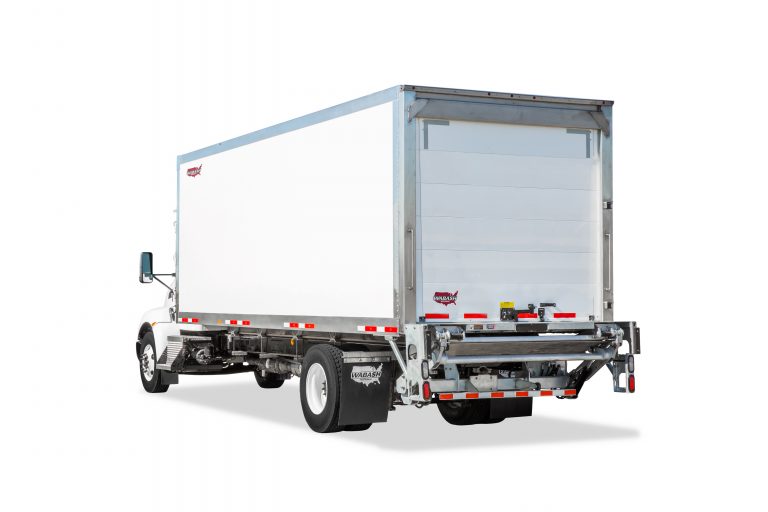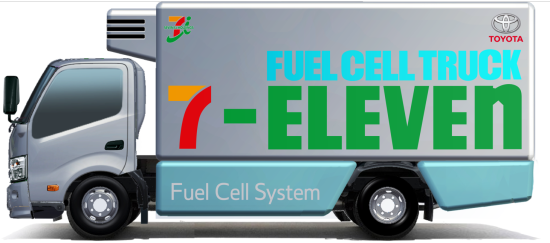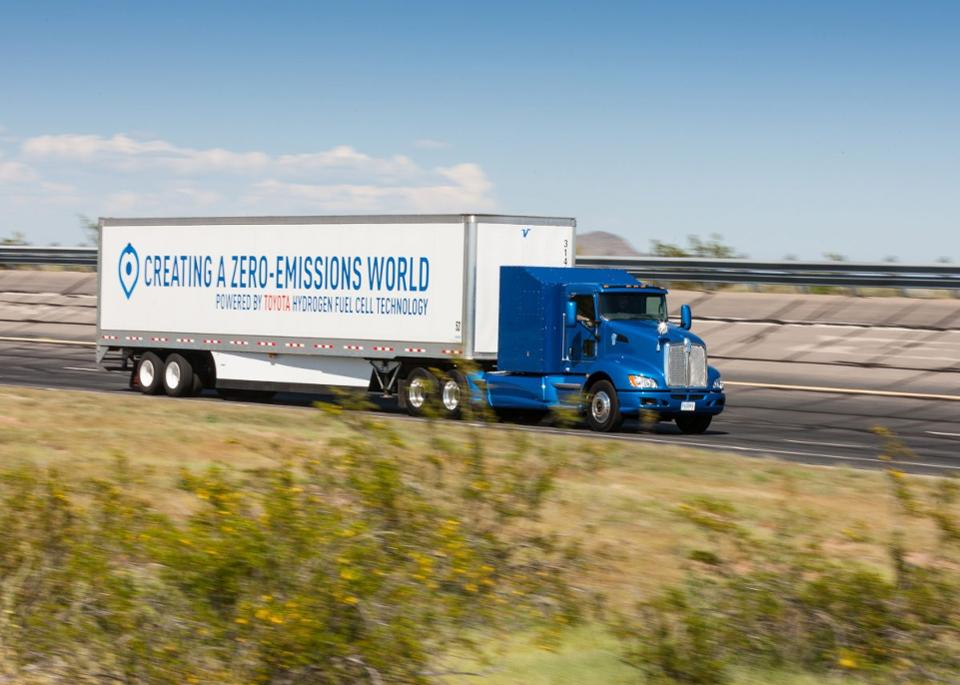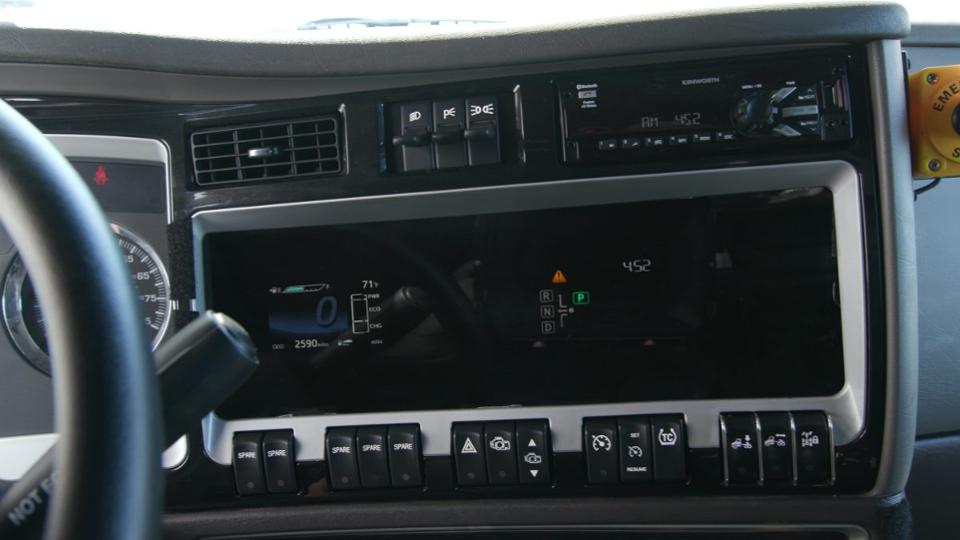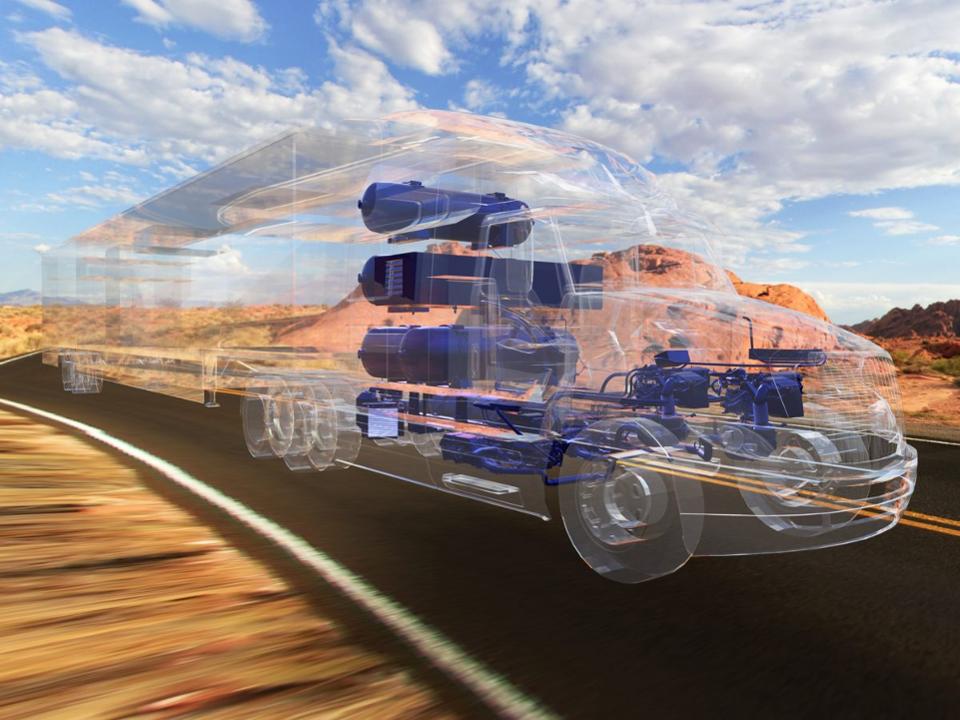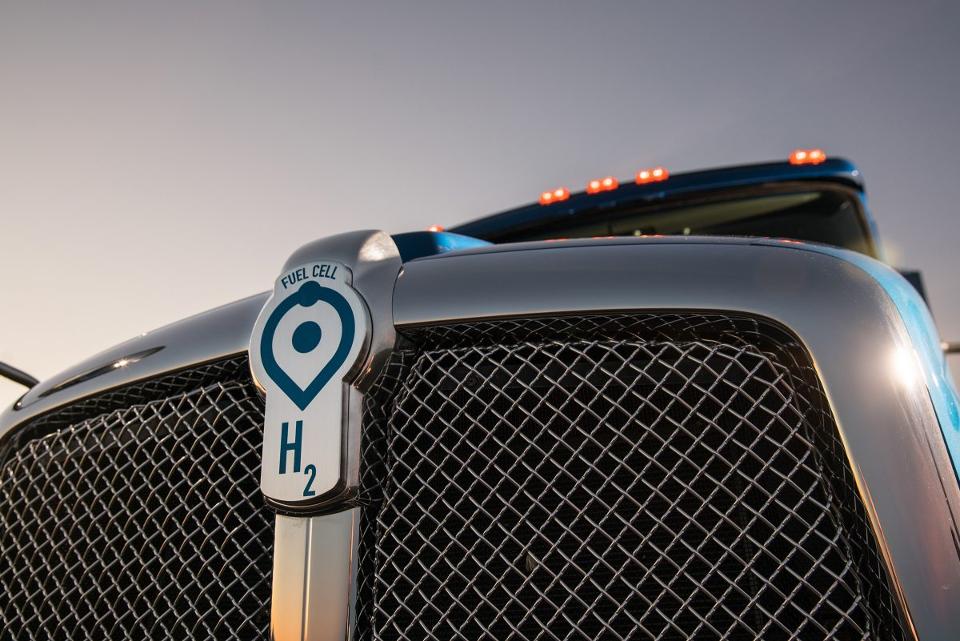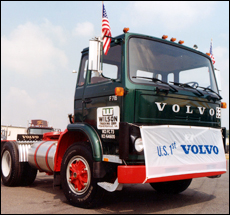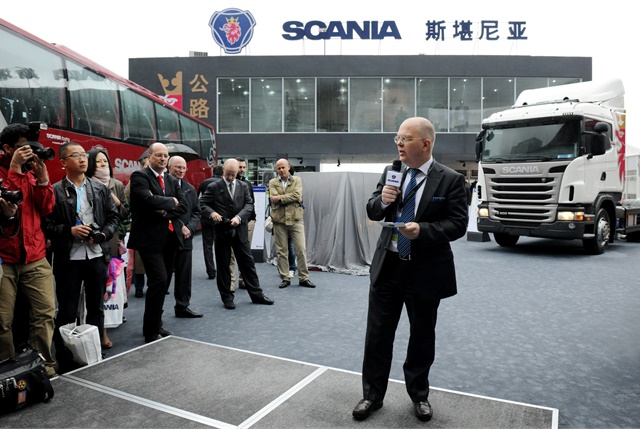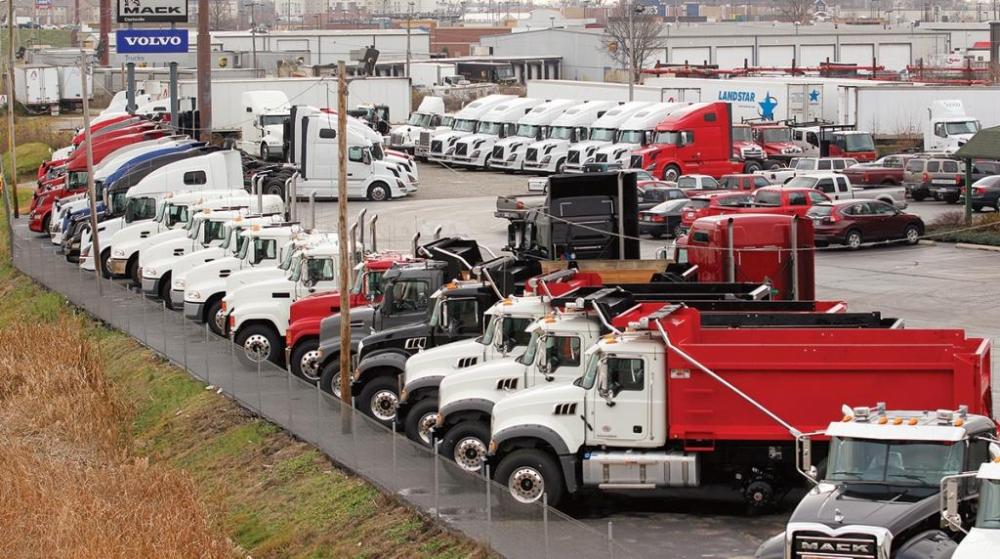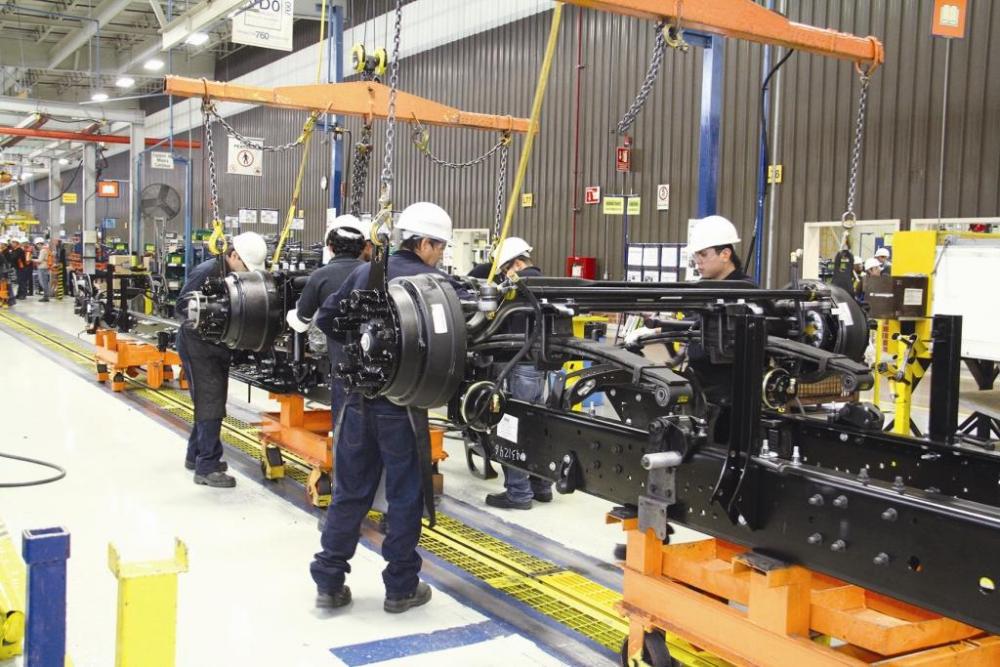
kscarbel2
Moderator-
Posts
18,875 -
Joined
-
Days Won
114
Content Type
Profiles
Forums
Gallery
Events
Blogs
BMT Wiki
Collections
Store
Everything posted by kscarbel2
-
Commercial Motor / August 9, 2017 Derbyshire haulier David G Davies & Sons has taken delivery of two of the UK’s first Iveco New Stralis XP tractor units. Supplied by Manchester-based Northern Commercials, the two 6x2 mid-lift tractors are the operator’s first ever Iveco trucks. They are equipped with 570hp Cursor 13 engines and 12-speed Hi-Tronix automated transmission, which Iveco has introduced for its XP models. Based at David G Davies & Sons’ Glossop site, they are expected to cover 140,000 miles annually and will be used to transport polystyrene packaging across the UK. They have been acquired on three-year Iveco Elements repair and maintenance contracts and join a 16-strong fleet previously dominated by a rival marque. Chris Davies, director at David G Davies & Sons, says: “From our initial enquiry, Paul Rankine at Northern Commercials has really looked after us. Paul ran simulations to demonstrate just how fuel-efficient the New Stralis XP would be, and when the time came to expand the fleet, Iveco was top of our shopping list. “On paper, New Stralis XP is a fantastic spec truck, but the full package Iveco is putting behind it – including the uptime guarantee – takes the aftersales support to a new level.” The uptime guarantee was launched alongside Iveco’s New Stralis XP and NP models and guarantees that the manufacturer’s dealer network will have the vehicle back on the road within 24 hours in the event of a breakdown. .
-
Jerry Hirsch, August 9, 2017 / Trucks.com Traditional trucking industry manufacturers could become obsolete if they don’t start moving more quickly into electric drive trains. That’s the assessment of analyst Alexander Potter from Piper Jaffray in a report released Tuesday for industry investors. “Many stocks in our truck coverage are exposed to disruption. Other than Wabco and Tesla we don't recommend buying any of them,” Potter said. Venerable industry suppliers such as Navistar International Corp., Paccar Inc., Cummins Inc. and Allison Transmission Holdings are among the most “susceptible,” Potter wrote. Potter is looking at the increasing adoption of electric buses demonstrates as the pathway to electric trucking, primarily through the development of drivetrain and battery technology. “Although California remains an early adopter of electric vehicles, the merits of electric drivetrains are now being acknowledged in regions far away from ‘friendly’ coastal enclaves,” Potter said. “Red states and blue states alike are embracing electric buses, and we see no reason why this trend should abate. Indeed, we expect it to accelerate,” Burlingame, Calif., electric bus maker Proterra opened a new factory in the City of Industry, just east of Los Angeles last month that is capable of building 400 electric buses annually in its 100,000-square-foot space. Elsewhere China-based BYD Co., has built a factory in Lancaster, Calif., to produce electric buses and trucks. The plant employs 600 workers and has already built 113 buses. Earlier this week, BYD said it inked a deal to supply 17 single-deck buses for service in Haifa, Israel’s third largest city. The buses will be operated by Egged, which with almost 3,000 buses is the country’s largest bus operator. Potter readily acknowledges the higher cost of electric vehicle technology, but he said that’s a passing issue and can be offset by operating savings. “It's important to note that electric bus volume is rising despite a sizable premium vs. internal combustion buses,” he said. An electric bus can cost about $700,000 while is diesel counterpart is $500,000. “But since regular maintenance costs for an EV bus are negligible – and since the energy savings are so substantial – the return on investment is still attractive,” Potter said. This is where the trucking industry needs take note, Potter said. “Naturally the economics are different in other vocations, but as volume rises and prices fall toward parity, other segments should steadily embrace EV drivetrains, including school buses, refuse trucks, and urban delivery fleets, more-or-less in that order,” he said. To be sure, there are plenty of hurdles. For example, there’s no national charging network to power long-haul trucks like there is for diesel vehicles, said Antti Lindstrӧm, an IHS Markit analyst. Another issue is charging time. Truckers won’t want to sit around waiting hours for their batteries to charge when they can refuel a diesel truck in minutes. That’s why both analysts expect to see electric trucks deployed first on routes where they head back to a central depot for charging. The key to driver of electric truck technology is the battery pack, where the “core” intellectual property resides, Potter said. “The pieces of metal in the drivetrain (motors, inverters, transmissions, axles) are simple, cheap, and in some cases not needed at all,” he said. “Consider the Tesla drivetrain: we think the bill-of-materials for the drivetrain itself is $1,500 or less, whereas the battery pack is probably at least 10x more costly.” The cost ratio becomes even more skewed in a heavy vehicle such as a truck or a bus because they require battery sizes of 400-600kWh, about five times larger than the battery Tesla uses in its biggest models. Some manufacturers are moving into the electric truck market. Tesla plans to reveal its design for a heavy-duty truck in September. Daimler Trucks just started production of an all-electric medium-duty truck this year called the eCanter under the Mitsubishi Fuso brand. It will be sold in the U.S., Europe and Japan. Both Daimler and Volkswagen, through its MAN Truck & Bus division, plan to introduce heavy-duty electric trucks around 2020. Toyota and others are working on hydrogen fuel cell trucks. The fuel cells create power to run electric drive trains in the trucks.
-
-
Heavy Duty Trucking / August 9, 2017 Hino Motors Manufacturing facility in Williamstown, W. Va., celebrated 10 years of medium-duty truck production. This 245,000 square-foot location produces Hino’s Class 6 & 7 conventional body style trucks. The West Virginia plant has seen exponential growth over its decade of production, facilitating the country’s fastest growing medium-duty truck, according to the manufacturer. “I want to thank all of the team members at the West Virginia facility. They are the heart and soul of our company. Without their commitment to quality, Hino Trucks would not be the premium brand name it is today. I would also like to thank the State of West Virginia, Wood County and the city of Williamstown for their tremendous partnership over the past 10 years.” said Yoshinori Noguchi, chairman of Hino Motors Manufacturing and President & CEO of Hino Motor Sales. This anniversary is a substantial milestone when considering the growth that Hino has experienced since 2007. Production per year has increased by more than 500% and the production facility has been expanded and capacities enhanced. “Our success has allowed us to invest in our capabilities to better service our customers as well as support the local job market. Since opening in 2007, the employment at our Williamstown facility has increased by over 400%," said Steve Stalnaker, vice president & plant manager Williamstown for Hino. As part of the 10-year celebration, Hino held an onsite ceremony to honor this achievement. The ceremony included statements from state and local government officials as well as Hino leadership. . . .
-
Wabash National acquiring truck body maker Supreme
kscarbel2 replied to kscarbel2's topic in Trucking News
Wabash to buy Supreme Industries Fleet Owner / August 9, 2017 The acquisition and subsequent merger of the two manufacturers is expected to occur no later than the fourth quarter of 2017. Trailer maker Wabash National Corp. aims to acquire fellow Indiana-based manufacturer Supreme Industries, which makes truck bodies, in a $21 per share stock offer worth between $342 million and $364 million. Founded in 1974, Supreme is the second largest U.S. manufacturer of truck bodies, with 2016 sales of $299 million, according to Wabash -- primarily building light- and medium-duty truck bodies at seven facilities throughout the U.S. Dick Giromini, Wabash’s CEO, said in a statement that the deal would merge the two companies and beef up Wabash’s own truck body manufacturing operations, positioning it to capitalize on the $2 billion “final mile” logistics market that’s rapidly increasing due to e-commerce activity. “We formally entered the final mile space in 2015 with the launch of our dry and refrigerated truck bodies, and we have been aggressively growing our presence and product offering over the past two years,” he explained. “This acquisition supports these efforts and accelerates our objective to transform our business into a more diversified industrial manufacturer.” Giromini noted that acquiring Supreme provides Wabash with “significant growth and diversification benefits” in line with the company’s long-term strategic plan, including reduced dependence on dry van trailer demand, "reduced cyclicality" and new segments for growth. Under the terms of the agreement and merger plan, Wabash formed an acquisition subsidiary – Redhawk Acquisition Corp. – that will commence a tender offer to purchase all outstanding shares of Supreme for $21 per share. The deal is expected to be wrapped up no later than the fourth quarter of this year. Following the completion of the tender offer, Wabash expects to consummate a merger of Redhawk Acquisition Corp. and Supreme in which shares of Supreme that have not been purchased in the tender offer will be converted into the right to receive the same cash price per share as paid in the tender offer. In all, Wabash expects the deal to deliver at least $20 million in annual “run-rate” cost synergies by 2021, with expected cost synergies primarily driven by corporate and procurement expenditures plus operational improvement savings. Over time, Wabash said it expects to achieve “significant incremental revenue opportunities” via its acquisition and merger with Supreme that neither company could obtain on a standalone basis. The Supreme acquisition is part of a larger “diversification” strategy on the part of Wabash that Giromini touched on in the company’s second quarter earnings call – a strategy aimed at “insulating” the company from the cyclical ups and downs in trailer demand. “Certainly, there is increased focus [on acquisitions]; we've stated that in recent quarters that with the health of the company, the strength of the balance sheet really provides us an opportunity to increase the focus and effort in that arena,” he explained during the company’s earnings call in late July. “We're taking more targeted approach; not simply waiting for opportunities to come across the transom,” Giromini added. “We're extremely excited about … the final-mile space. It's an area that we have invested in and continue to invest in organically here. And we continue to look at opportunities in that space to grow through strategic acquisition.” And the money is apparently there to do it. On a consolidated basis, Wabash booked revenue of $436 million in the second quarter this year, which is a decrease of $36 million or 8% compared to the second quarter of 2016, with new trailer shipments reaching 14,150 units. In terms of operating results, Wabash reported consolidated gross profit in the second quarter of $57.7 million or 15.5% of sales. Gross profit was down $23.4 million year-over-year and up $8.3 million sequentially, the company added, while it generated operating income and margin of $38.7 million and 8.9%, respectively. . -
The Electronic Logging Device (ELD) Controversy
kscarbel2 replied to kscarbel2's topic in Trucking News
ELDs Must Be Registered at FMCSA, Official Reminds Safety Inspectors Transport Topics / August 9, 2017 ORLANDO, Fla. — Electronic logging devices need to be registered with the federal trucking regulatory agency in order to be valid, an agency official reminded law enforcement officials on Aug. 9. “It’s not an ELD unless it’s listed on our website. That’s going to be part of what you do during an inspection; you’re going to verify that it is a registered ELD,” said Danielle Smith, a transportation specialist with the Federal Motor Carrier Safety Administration’s passenger carrier division. Smith was addressing road safety inspectors at the North American Inspectors Championship, hosted by the Commercial Vehicle Safety Alliance. During her half-hour lecture, Smith reminded inspectors about ELDs’ data transfer procedures via wireless applications, email, Bluetooth devices or USB ports. She also noted carriers have to repair or replace malfunctioning ELDs within eight days of learning about problems with the devices. The agency’s ELD rule takes effect Dec. 18. Its aim is to establish performance and design standards, as well as improve compliance with hours-of-service rules. Marc Moncion, global director of safety, compliance and regulatory affairs with Fleet Complete, urged drivers to embrace ELDs. His firm’s ELDs are powered by BigRoad. “Don’t fear the technology because the technology is not Big Brother,” Moncion told Transport Topics. “It’s geared to leverage efficiencies.” -
Wabash National acquiring truck body maker Supreme
kscarbel2 replied to kscarbel2's topic in Trucking News
Wabash Reaches Agreement to Acquire Supreme Industries Transport Topics / August 9, 2017 Trailer maker Wabash National Corp. has reached an agreement to acquire truck-body manufacturer Supreme Industries, a move that would catapult Wabash to the second-largest U.S. truck-body manufacturer as it expands its focus on e-commerce equipment. Wabash announced Aug. 8 a cash tender offer for $21 per share, which represents an equity value of $364 million and an enterprise value of $342 million for Supreme. Founded in 1974, Supreme is the second-largest U.S. manufacturer of truck bodies, with 2016 sales of $299 million, according to Lafayette, Ind.-based Wabash. Supreme, based in Goshen, Ind., primarily manufactures light- and medium-duty truck bodies at seven factories across the United States. One analyst, responding to the news, was supportive. “Our initial thoughts are mildly positive on the deal as it 1) further diversifies Wabash away from the 53-foot dry-van trailer industry, 2) will be accretive to earnings and 3) should not be viewed as a ‘bet-the-farm transaction,’ ” analyst Brad Delco with Stephens Inc. wrote in a note to investors. With the acquisition completed, Wabash would trail only Morgan Corp. in the truck body manufacturing industry, Delco told Transport Topics. “Supreme has about 17% share of the market, whereas Morgan has about 40%. No other trailer manufacturer will have as much exposure to the truck body, final-mile e-commerce market as WNC, though, to say it differently.” “Wabash National has been closely monitoring the transportation landscape as the growth of e-commerce has continued to change the logistics model,” Wabash CEO Dick Giromini said in a statement. “We formally entered the final-mile space in 2015 with the launch of our dry and refrigerated truck bodies, and we have been aggressively growing our presence and product offering over the past two years. This acquisition supports these efforts and accelerates our objective to transform our business into a more diversified industrial manufacturer.” Once the transaction is complete, Wabash would see its revenue from dry van semi-trailer manufacturing fall to “an expected” 50% in 2018, compared with 64% in 2016,” Stifel, Nicolaus & Co. analyst Michael Baudendistel wrote in a note to investors. Wabash expects to deliver at least $20 million in annual run-rate cost synergies by 2021, primarily driven by corporate and procurement expenditures, and operational improvement savings, according to the company. Over time, Wabash expects to achieve significant incremental revenue opportunities that neither company could obtain on a stand-alone basis, but it did not elaborate in its statement. “This is a great opportunity for both companies to combine our strengths to provide an enhanced customer experience within the growing final-mile delivery space,” Giromini added. “With Supreme, not only can Wabash National accelerate organic growth with our innovative DuraPlate, honeycomb panel and molded structural composite truck bodies, we can also provide a broader conventional product offering to our existing customer base.” The merger, when approved, will enhance Supreme’s ability to “innovate more quickly and create more value for customers,” Supreme Industries CEO Mark Weber said in a statement. “We found a cultural fit with Wabash National. Because of their commitment to safety, innovation and customer relationships, I’m confident joining the Wabash National family will benefit our employees, customers and distributors.” Trailer maker Great Dane also owns Johnson Refrigerated Truck Bodies, which makes bodies for medium-duty trucks carrying temperature-sensitive products, including for home delivery, Great Dane said on its website, and the equipment is available through authorized Great Dane branches and select dealerships. . -
Jason Cannon, Commercial Carrier Journal (CCJ) / August 8, 2017 Wabash National Corporation is acquiring truck body builder Supreme Industries, Inc. Under the terms of the deal, Wabash National will acquire all outstanding shares of Supreme in a cash tender offer for $21 per share – a value of $364 million. Both companies are based in Indiana but Supreme – the second largest U.S. manufacturer of truck bodies – primarily manufactures light- and medium-duty bodies at seven U.S. facilities. Wabash National Chief Executive Officer Dick Giromini says the semi trailer maker was drawn to the deal as his company seeks to further expand its final-mile business, which Wabash entered in 2015 with the debut of dry and refrigerated truck bodies. “Wabash National has been closely monitoring the transportation landscape as the growth of e-commerce has continued to change the logistics model,” he says. Supreme’s medium- and light-duty commercial vehicle portfolio, distribution network, and regional manufacturing locations will combine with Wabash National’s advanced composite technologies, expertise in lean manufacturing and optimization, engineering and design proficiency and supplier relationships. .
-
New Ford F-150: Most Advanced F-150 Powertrain Lineup Ever Enables Best-in-Class Payload, Towing and Gas Mileage With more engine choices, the 2018 F-150 is even more fuel-efficient; its second-generation 2.7-liter EcoBoost has an EPA estimated rating of 20 mpg city, 26 mpg highway and 22 mpg combined which is best-in-class. New F-150 debuts with new, best-in-class 13,200-pound tow rating – thanks to more powerful, efficient engine offerings featuring standard Auto Start-Stop and expanded availability of segment-first 10-speed SelectShift® automatic transmission New truck sports a tougher design with bolder Built Ford Tough styling and its high-strength, military-grade, aluminum-alloy body and box Using available class-exclusive Pre-Collision Assist with Pedestrian Detection and adaptive cruise control with stop-and-go functionality, the 2018 F-150 can assist drivers in congested traffic – even applying brakes to help prevent a collision; available Wi-Fi hotspot helps occupants stay connected on the go DEARBORN, Mich., Aug. 9, 2017 – Ford’s new F-150 debuts for 2018 even tougher, even smarter, and even more capable than ever – with the most advanced F-150 powertrain lineup ever that delivers best-in-class towing, payload and efficiency for America’s pickup drivers. The new F-150 has an EPA estimated rating of 20 mpg city, 26 mpg highway and 22 mpg combined which is best-in-class from the second-generation 2.7-liter EcoBoost engine, plus best-in-class towing (13,200 lbs.) and payload capacity (3,270 lbs.) from the 3.5-liter EcoBoost and enhanced 5.0-liter V8, respectively. “The Ford F-150 lineup again delivers on its promise to give full-size truck customers even more value, functionality and smart technology innovations, with engines with best-in-class towing, payload and fuel economy,” said Todd Eckert, Ford truck group marketing manager. “Our new F-150 highlights Ford’s commitment to its hardworking truck customers and how we listen to their demands for their new F-150 to be even tougher, even smarter and even more capable for work and play.” Three years after introducing a high-strength, military-grade, aluminum-alloy-bodied F-150, a new truck arrives with bold new styling, advanced technologies, a segment-first 10-speed automatic transmission and F-150’s most advanced engine lineup yet, which includes the first available diesel ever for F-150. F-150 is part of Ford’s F-Series truck lineup – America’s best-selling truck for 40 consecutive years and its best-selling vehicle for 35 years. New powertrain lineup for available best-in-class payload, towing and gas mileage The new F-150 offers the F-150’s most advanced engine offerings ever – all to offer the right engine for every hardworking truck customer. An second-generation 2.7-liter EcoBoost® V6 with segment-exclusive SelectShift® 10-speed automatic transmission has an EPA-estimated rating of 20 mpg city, 26 mpg highway and 22 mpg combined which is best-in-class. With advanced dual port and direct-injection technology, the second-generation 2.7-liter EcoBoost engine delivers a 25 lb.-ft. increase in torque – and at lower engine speeds compared to a traditional V8. Like the second-generation 3.5-liter EcoBoost, this 2.7-liter EcoBoost will be paired with Ford’s segment-exclusive 10-speed SelectShift automatic transmission. An enhanced 5.0-liter V8 boasts a best-in-class payload capacity of 3,270 pounds. This normally aspirated engine features significant upgrades for 2018 including advanced dual port and direct-injection technology for 10 more horsepower and an additional 13 lb.-ft. of torque. Spray-on bore liner technology also featured in the Shelby GT350® Mustang has been added to squeeze out even more weight from the aluminum block. For the first time, the V8 is paired with the 10-speed SelectShift automatic. For best-in-class towing, the second-generation 3.5-liter EcoBoost V6 delivers 13,200 pounds of towing capacity, thanks to its 470 lb.-ft. of torque that beats all diesel- and gasoline-powered competitors, including V8 engines with nearly twice its displacement. With dual port and direct-injection technology, the 375-horsepower twin-turbo engine provides ideal low-end and peak engine performance for hauling heavy payloads and towing heavy trailers. Even the all-new 3.3-liter V6 engine is more efficient, more powerful and delivers more torque to get the job done, compared to the previously standard 3.5-liter V6. Plus, the now standard 3.3-liter provides a 5 percent power-to-weight ratio improvement versus the 2014 F-150 featuring steel body and 3.7-liter V6 – with better fuel economy and performance based on EPA-estimated ratings. Designed, engineered and tested in-house, an all-new 3.0-liter Power Stroke® turbo diesel V6 paired with 10-speed SelectShift automatic joins the F-150 engine lineup for 2018. The first diesel engine offered for F-150 will be available next spring. F-150’s new powertrain lineup New F-150 offers the most advanced engine offerings ever, including standard Auto Start-Stop. Specifically: 3.3-liter PFDI V6 2.7-liter EcoBoost V6 5.0-liter PFDI V8 3.5-liter EcoBoost V6 3.5-liter high-output EcoBoost V6 Horsepower 290 @ 6,500 rpm 325 @ 5,000 rpm 395 @ 5,750 rpm 375 @ 5,000 rpm 450 @ 5,000 rpm Versus 2017 +8 No change +10 Torque (lb.-ft.) 265 @ 4,000 rpm 400 @ 2,750 rpm 400 @ 4,500 rpm 470 @ 3,500 rpm 510 @ 3,500 rpm Versus 2017 +12 +25 +13 EPA fuel economy 4x2 19 mpg city, 25 mpg highway, 22 mpg combined 4x4 18 mpg city, 23 mpg highway, 20 mpg combined 4x2 20 mpg city, 26 mpg highway, 22 mpg combined 4x4 19 mpg city, 24 mpg highway, 21 mpg combined 4x2 17 mpg city, 23 mpg highway, 19 mpg combined 4x4 16 mpg city, 22 mpg highway, 18 mpg combined 4x2 18 mpg city, 25 mpg highway, 21 mpg combined 4x4 17 mpg city, 23 mpg highway, 19 mpg combined 4x4 15 mpg city, 18 mpg highway, 16 mpg combined Versus 2017 4x2 +1 mpg city, +1 mpg highway, +2 mpg combined 4x4 +1 mpg city, +1 mpg combined 4x2 +1 mpg city 4x4 +1 mpg city, +1 mpg highway, +1 mpg combined 4x2 +2 mpg city, +1 mpg highway, +1 mpg combined 4x4 +1 mpg city, +1 mpg highway, +1 mpg combined Raising the bar through segment-exclusive materials and technologies More than just styling that creates visually bolder and more planted stance, the new F-150 continues to offer a segment-exclusive combination of advanced materials that have proven durability through extensive real-world performance and inhibit corrosion. A high-strength, military-grade, aluminum alloy body and box that saves weight and adds capability coupled with a high-strength steel fully boxed ladder frame. The new Ford F-150 further advances the light-duty pickup truck market with segment-first and class-exclusive technologies that improve productivity, efficiency and driver confidence, while keeping occupants connected to the world around them. Technologies include: New segment-first enhanced adaptive cruise control with stop-and-go functionality is available to allow drivers to set a cruising speed. The system then uses radar and camera technology to monitor traffic ahead to maintain a set distance between vehicles – even following a vehicle down to a complete stop New segment-first Pre-Collision Assist with Pedestrian Detection is available to help drivers avoid or mitigate collisions with other vehicles and pedestrians An available new embedded 4G LTE modem with Wi-Fi hotspot enables customers to connect up to 10 mobile devices at one time, virtually anywhere New B&O PLAY audio system is available, offering high-end speakers, sound and tuning for a richer, more engaging listening experience Existing segment-exclusive driver-assist and convenience features include: Available Pro Trailer Backup Assist allows F-150 drivers of various skill levels to steer a trailer instinctively using a center console-mounted dial to back-up a boat launch or park in a driveway Available Blind Spot Information System with trailer coverage technology is optimized for F-150 to include up to 33 feet of trailer length; BLIS® uses radar sensors in the taillamps to monitor areas that may not be visible to the driver around the truck and trailer Available 360-degree camera technology helps improve driver confidence when parking and can help reduce stress when connecting a trailer – allowing customers to see more so they can focus on specific tasks such as lining up a hitch Available lane-keeping system is designed to help reduce drifting of the truck outside its intended lane The new 2018 Ford F-150 goes on sale this fall. It will be built at Dearborn Truck Plant in Dearborn, Michigan, and Kansas City Assembly Plant in Claycomo, Missouri. Photo gallery - https://media.ford.com/content/fordmedia/fna/us/en/news/2017/08/09/new-ford-f150-most-advanced-powertrain-lineup-ever.html
-
Green Car Congress / August 9, 2017 Seven-Eleven Japan Co., Ltd. and Toyota Motor Corporation have concluded a basic agreement for studies on energy conservation and CO2 emissions reduction in convenience store distribution and operation. The two companies aim to contribute to the realization of a low-carbon and hydrogen-based society in the future, by way of introducing vehicles and power generators to be newly developed by Toyota that use hydrogen. Fuel cell trucks, in which the refrigeration/freezer unit, and the truck itself, are powered by fuel cells, will be introduced as refrigerator/freezer trucks for stores with the goal of reducing CO2 emissions. For the stores, an energy management system, combining already-installed solar power generators hydrogen systems will be introduced to enable greater energy conservation and CO2 emissions reduction. · Under consideration is the utilization of a fuel cell power generator as a power source at stores with hydrogen stations. The stationary hydrogen generator would utilize an automotive fuel cell unit. · A stationary rechargeable battery system which uses rechargeable automobile batteries will be introduced to stores and may be used as an emergency power source during disasters, in addition to possible applications for energy conservation and CO2 emissions reduction. .
-
Former FCA analyst Durden pleads guilty to conspiracy Automotive News / August 8, 2017 ANN ARBOR, Mich. -- One of two Fiat Chrysler officials so far charged in a conspiracy to embezzle millions from a joint FCA-UAW training fund pleaded guilty this morning in U.S. District Court. Jerome Durden, 61, pleaded guilty to one count of conspiracy to defraud the U.S. government, a felony, and one misdemeanor charge of failing to file a tax return for the approximately $4,000 he received in 2013 under the conspiracy. Durden, who was a financial analyst at FCA, is expected to cooperate with prosecutors as they build their case against other conspirators, including Alfons Iacobelli, FCA's former head of labor relations, and Monica Morgan, the wife of the late General Holiefield, former head of the UAW's Chrysler department. Iacobelli and Holiefield are alleged by the government to have embezzled millions from the FCA-UAW Joint Training Center in 2009-14. Durden faces a maximum of 37 months in federal prison when he is sentenced at 9:30 a.m. Dec. 12 in U.S. District Court here. He remains free on bond pending sentencing and completion of a pre-sentence report by the court's probation department. Durden entered his guilty plea on Tuesday morning before U.S. District Judge John Corbett O'Meara.
-
Toyota Explores Heavy Truck Hydrogen Fuel Cell Application
kscarbel2 replied to kscarbel2's topic in Trucking News
Toyota's Hydrogen Fuel Cell Kenworth Can Revolutionize Heavy Transport Forbes / August 9, 2017 “We took two Mirai vehicles, tore them apart and integrated components into the Kenworth. This was a fast development program. The tanks are larger. Battery is larger. Motors are completely different from Mirai. But the two fuel-cell stacks are Mirai production units. The main purpose is to prove scalability of the Mirai system with little change to the rest of the truck. Our system can pull an 80,000-lb. combined load up a hill,” says Chris Rovik, engineering manager of Toyota Motor North America’s “Portal Project,” an effort to develop a fleet of zero-emission semi tractor-trailers to haul freight from the world’s two busiest container ports, Long Beach and Los Angeles, to a railhead well beyond the densely populated Southern California coastline. The I-710 freeway corridor in and out of these twin ports is nicknamed “cancer alley” because diesel emissions have blanketed the area for decades. The ports are not allowed to expand because of their current high levels of pollution. Rovik and Giorgio Zoia, who works in Toyota’s fuel-cell development program, are my hosts for a crawl-around and drive session of their fuel cell Kenworth T680 “Glider” at Toyota’s Arizona proving grounds. Two electric motors mounted under the cabin generate 1325 lb-ft of torque and the electric equivalent of 670 horsepower, comparable to the conventional 10.8-liter diesel that would normally sit in the Kenworth’s nose. For our run around the proving grounds, there’s no trailer with 45,000 pounds of cargo—we’re in street racing trim. Pedal down, the big blue Kenworth hits 60 mph in about seven seconds, producing no emissions beyond a stream of water. Working our way back to the garage through a series of control gates, I wonder if Toyota might consider entering a fuel-cell prototype racecar at the 24 Hours of Le Mans in the “Garage 56” experimental class. That might generate much more press than winning the race. “We are trying to keep the battery as small as possible. We want to demonstrate scalability of the fuel cell itself,” says Rovik. “The motors are in series, attached to each other. The back of the vehicle is exactly like a Kenworth PACCAR [diesel-powered] vehicle. People with commercial truck experience are impressed with how quick it is, especially under heavy load,” Rovik says. “These are semi-custom tanks bought from a supplier. It is a translation of the tanks for CNG. Each is almost double the size of a Mirai tank,” Zoia says of the two tanks mounted in the space that would comprise a sleeper cabin in a conventional Kenworth. Hydrogen is delivered to the tanks with the same milled aerospace-quality nozzles I used during a two-week Mirai test drive. Refueling takes 30 minutes because a hydrogen chilling system was deemed an unnecessary expense. “If you have a chiller in the station, you can shorten the fueling time,” says Zoia. Considering Toyota’s commitment to this technology, it’s feasible that within the 2 or 3 years a fuel cell powerplant might be built to generate hydrogen through electrolysis, and power all proving ground operations. “Fuel cells are already very efficient. Fuel cells are getting cheaper. They were expensive because of the platinum and to get hydrogen to go through the membrane. Now quantity of expensive materials is getting lower,” says Zoia. Joan Ogden, Professor of Environmental Science and Policy and Director of the Sustainable Transportation Energy Pathway Program at the UC Davis Institute of Transportation Studies, says, “We talked to people in the platinum business, and it turns out that almost all of them foresee going from 50 percent recycling to essentially 100 percent in the future. Platinum is going to be in demand for a lot of things. Not only for fuel cells, but for other kinds of clean processes. You won’t be mining so much virgin platinum as reprocessing it.” Conventional catalytic converters in gasoline-powered road cars use perhaps 2 to 4 grams of platinum. Currently, fuel-cell vehicles use about twice that, so the amounts of platinum are not radically greater. “Hydrogen is an energy carrier. How you make hydrogen is the environmental impact,” says Zoia, who chooses the least attractive source of hydrogen to illustrate. “If you make hydrogen from coal, it produces a lot of CO2. You can do it in a centralized facility, capture the CO2 and sequester it. It takes away completely the issue of distributed pollution from smaller sources.” No matter if the source of hydrogen is coal or natural gas, carbon emissions can be sequestered at the energy plant, and hydrogen fuel-cell vehicles themselves produce no emissions. “If you make hydrogen with electrolysis from wind power, there is zero effect on the environment. The main production source now is natural gas, a relatively clean way of making hydrogen. You have one carbon with four hydrogens in a long chain. “The final goal if you want to be CO2 emission-free is to produce hydrogen from sources that do not produce CO2,” says Zoia. “It could be from renewable natural gas, from landfills. It could be electricity from solar, from hydro, and frankly, it could be from nuclear power. These are completely CO2-free ways of making electricity. You split water in electrolysis. Right now, the process has room for improvement in its efficiency so it is relatively more expensive than producing hydrogen from natural gas. “Say you create electricity from solar or wind, but how do you store it? Hydrogen is the perfect way to store energy,” says Zoia, “because it can be reversed into electricity very efficiently through fuel cells, or it can be transported through a pipeline.” California solar farms have produced so much electricity during daylight hours that in 2017 utility companies in neighboring states have been paid to accept electricity to avoid overloading the California grid. If excess solar power is instead used to power electrolysis and the resulting hydrogen is piped to Los Angeles to power vehicles, a hydrogen-based industrial infrastructure begins to emerge. FuelCell Energy of Danbury, Connecticut, markets fuel-cell powerplants that can generate from 1.4MW to 3.7MW, using natural gas or biogas. For measureables, 1MW can power about 1000 homes. FuelCell Energy’s main clients are hospitals, universities, and wastewater treatment plants. They are currently developing a multi-unit powerplant in the heart of Long Island. “Our core commercial line of fuel-cell powerplants runs on natural gas or methane-based biogas,” says Tony Leo, VP of Application Engineering and New Technology Development at FuelCell Energy. “They cannot run on pure hydrogen. We are introducing a version that produces hydrogen. The fuel cells convert natural gas to hydrogen inside the fuel cell and make electricity from that, but they can also produce extra hydrogen. “We are developing, though it is not yet commercial, a solid-oxide fuel cell that can run on pure hydrogen,” says Leo. “We are looking at using it for electrolysis as well as pure hydrogen consumption. This is a very efficient platform for electrolysis. You can take intermittent renewable power [solar and wind] and send it into a solid-oxide cell and turn water into hydrogen and oxygen. And then store that hydrogen for reconversion into power later, sending it to the same stack. Or you can dispense it to fuel-cell vehicles. We are in the process of testing our first 200KW prototype solid-oxide fuel cell, a prototype of what will be a commercial platform, extending into electrolysis and storage. We have internal support, but also funding from the U.S. Department of Energy. It’s about two or three years till commercialization.” “We are also developing a modification of the system that will allow the fuel cells to support CO2 capture,” says Leo. “You can take exhaust from a coal or natural gas powerplant, send it into our fuel cell and it will separate the CO2 so that it can either be used or sequestered. That is our carbon capture application.” Fuel-cell powerplants are quiet and emit no objectionable emissions that might raise not-in-my-backyard objections. FuelCell Energy’s stacks last about five years, but the rest has a much longer lifespan. Because they are clean, they can place power generation right where it is needed, not miles away feeding an inefficient grid. “Hydrogen pipelines are not more expensive than natural gas pipelines,” says Zoia. “There is one under the 405 freeway in Los Angeles. There are few pipelines because hydrogen is not used widely, only in refineries.” Hydrogen generated through fuel cell electrolysis can be stored at a powerplant and reused to generate electricity at night, or on rainy days. Regarding concerns about the nature of hydrogen, Zoia is succinct: “How long would it take our truck’s hydrogen tanks to empty if we left them? One kilogram of hydrogen has about the same energy as one gallon of gasoline. These tanks in the truck have about 40 kilos of hydrogen. It would take 1500 years for the hydrogen in our tanks to permeate into the atmosphere. The tanks have been shot in test facilities with a .50-caliber bullet and nothing happens. The only way to have a leak from those tanks is at the valve. Worst case if the valve completely failed, it would take just a few minutes for the hydrogen to completely disperse.” It’s important to note that the Department of Energy is researching means of storing hydrogen in caverns in quantities large enough to fuel a powerplant for five or six days. “Hydrogen has safety issues different from gasoline, but when used properly it is as safe as other fuels. Hydrogen has a pretty wide flammability region, but it disperses quickly. It is lighter than air. You design infrastructure to adapt to that,” says Zoia. In short, architecture of parking structures, home garages, tunnels, and other closed storage for vehicles needs to be vented, though the steps needed are not far beyond those for gasoline-powered cars. Having been in Toyota’s fuel cell Kenworth, I’ve reached a variation on the same conclusion for the Mirai fuel-cell passenger car: it’s a truck. There’s no Buck Rogers to it, no George Jetson, no Star Wars. It simply works, and works quite well, a fuel-cell hybrid vehicle (FCHV) powered with hydrogen. Again, the only element standing in its way is production and distribution infrastructure for hydrogen, which can potentially be addressed in a few years, at least here in my native Los Angeles. Combined with Toyota’s recently announced breakthroughs in solid-state batteries that can potentially transform the electric vehicle market, fuel cell work vehicles offer a completely new approach to heavy transport in an industrialized society. The drive system Rovik and Zoia have put together can just as easily power John Deere harvesting combines in the wheat fields of South Dakota, buses in Los Angeles, heavy cranes for unloading ships in ports, and UPS trucks. At the other end of the scale, fuel cells can power forklifts at a port. Though it has only been mentioned once or twice in public, Toyota has a fuel-cell system scaled to power a Tundra work pickup, proving that most if not all vehicles and equipment at a port can be powered by hydrogen, which becomes especially easy if fuel cell powerplants capable of electrolysis are sited at or near the port. This topic is far removed from the high-performance and luxury cars I normally cover, but I am hoping Toyota invites me on a delivery run in this Kenworth out of the port to the railhead. . -
Reuters / August 9, 2017 SAN FRANCISCO -- Tesla Inc is developing a long-haul, electric semi-truck that can drive itself and move in "platoons" that automatically follow a lead vehicle, and is getting closer to testing a prototype, according to an email discussion of potential road tests between the car company and the Nevada Department of Motor Vehicles, seen by Reuters. Meanwhile, California officials are meeting with Tesla on Wednesday "to talk about Tesla's efforts with autonomous trucks," state DMV spokeswoman Jessica Gonzalez told Reuters. The correspondence and meeting show that Tesla is putting self-driving technology into the electric truck it has said it plans to unveil in September, and is advancing towards real-life tests, potentially moving it forward in a highly competitive area of commercial transport also being pursued by Uber Technologies Inc and Google affiliate Waymo. After announcing intentions a year ago to produce a heavy-duty electric truck, Musk tweeted in April that the semi-truck would be revealed in September, and repeated that commitment at the company's annual shareholder meeting in June, but has never mentioned any autonomous-driving capabilities. Tesla has been a leader in developing autonomous driving capability for its luxury cars, including the lower-priced Model 3, which it is beginning to manufacture. Long-haul potential Several Silicon Valley companies developing autonomous driving technology are working on long-haul trucks. They see the industry as a prime early market for the technology, citing the relatively consistent speeds and little cross traffic trucks face on interstate highways and the benefits of allowing drivers to rest while trucks travel. Some companies also are working on technology for "platooning," a driving formation where trucks follow one another closely. If trucks at the back of the formation were able to automatically follow a lead vehicle, that could cut the need for drivers. An email exchange in May and June between Tesla and Nevada DMV representatives included an agenda for a June 16 meeting, along with the Nevada Department of Transportation, to discuss testing of two prototype trucks in Nevada, according to the exchange seen by Reuters. "To insure we are on the same page, our primary goal is the ability to operate our prototype test trucks in a continuous manner across the state line and within the States of Nevada and California in a platooning and/or Autonomous mode without having a person in the vehicle," Tesla regulatory official Nasser Zamani wrote to Nevada DMV official April Sanborn. No companies yet have tested self-driving trucks in Nevada without a person in the cab. On July 10, Zamani inquired further to the Nevada DMV about terms for a testing license, an email seen by Reuters shows. California DMV spokeswoman Gonzalez said that Tesla had requested a meeting on Wednesday to introduce new staff and talk about Tesla’s efforts with autonomous trucks. She said that the DMV was not aware of the level of autonomy in the trucks. Tesla declined to comment on the matter, referring Reuters to the previous statements by Musk, who has discussed the truck in tweets and at the annual shareholder meeting. Nevada officials confirmed the meeting with Tesla had occurred and said that Tesla had not applied for a license so far. They declined to comment further. Skeptics Musk has said that potential customers are eager to get a Tesla electric long-haul truck, but he faces doubt that the company can deliver. While established trucking companies and truck manufacturing startups have poured resources into electrifying local package delivery fleets, battery range limitations have largely kept the industry from making electric trucks that travel across swaths of the country. Lithium ion battery researcher Venkat Viswanathan of Carnegie Mellon University said electric long-haul trucking is not economically feasible yet. “Your cargo essentially becomes the battery,” Viswanathan said of the massive batteries that would be needed to make range competitive with diesel. Diesel trucks used for cross-country hauls by United Parcel Service Inc. can travel up to 500 miles on a single tank, according to UPS's director of maintenance and engineering, international operations, Scott Phillippi. By comparison, the company's electric local package delivery trucks travel up to 80 miles on a full charge.
-
Class 7 or 8, depending on how it's spec'd. It remains a mystery to Mack brand dealers why Volvo doesn't offer the 220 to 330 horsepower Volvo D8 (rebadged UD GH8E) in the Granite MHD so they might attempt to be competitive once more in the municipal segment.
-
I don't care for this at all, the round single letter icons and all the rest.
-
What is this gasket
kscarbel2 replied to MHfred's topic in Antique and Classic Mack Trucks General Discussion
It's been ages, but is that not the RH door window and (sleeper models) bunk vent rubber gasket? (Then again, that might be 570AMM1M) -
What axles do you have ?
-
86' Superliner RW613 hard steering
kscarbel2 replied to Korman Trucking's topic in Driveline and Suspension
You didn't mention which of the two possible gears you had, nor your axle size. But this info should suffice. TRW - HFB64 Service Manual https://www.trwaftermarket.com/globalassets/na/trucksteering---literature/steeringgears-lit/steeringgears-sm/hfb-64/hfb64.pdf Sheppard - 92 Series Service Manual http://www.rhsheppard.com/wp-content/uploads/2014/08/92_Series_Service_Manual.pdf -
Fishersville, Virginia-based Wilson Trucking (near the I-81/I-64 intersection) was Volvo's single largest US F6/F7 operator for years and years. Volvo decided to give them deep pricing to gain market visibility when they had.......none. This year, Texas-based Central Freight Lines purchased Wilson........... https://www.bigmacktrucks.com/topic/48845-wilson-trucking-to-be-sold/#comment-362337 .
-
Heavy Duty Trucking / August 8, 2017 A full 20% of Chinese carriers plan to upgrade their trucks and purchase a European-built model with their next vehicle purchase. That’s good news for European truck OEMs, which have spent the better part of the past two decades slowly building their reputations and customer base in the world’s most populous nation. According to a report compiled by Bain Insights and published on the Forbes website last month, most Chinese carriers still intend to purchase domestic- or European-Chinese-joint venture trucks the next time they upgrade their fleets. But this does little to dampen the good news for European OEMs, which the study found enjoy significantly higher customer loyalty rankings than Chinese and joint venture (JV) trucks. Moreover, the findings indicate a substantial number of Chinese fleets are prosperous enough now to pay more for better quality trucks, stay with those brands longer, and generate positive word of mouth about the vehicles. Even better: The majority of respondents who indicated a preference for European-built trucks also indicated they plan to purchase new vehicles in the next three years. According to the Bain analysts, the study also points to a Chinese trucking industry that is maturing rapidly, as more truck buyers there are increasingly focused on total cost of vehicle ownership, including fuel economy. This dovetails with additional shifts in the Chinese trucking industry identified in the report, which notes that early Chinese fleet operations were focused in construction applications as the country launched a massive infrastructure modernization program. But now they appear to be moving toward more logistics-style long- and short-haul applications. European OEMs still have work to do, the Bain report noted, including localizing production to further reduce acquisition costs and develop deeper sales and service networks. .
-
The Electronic Logging Device (ELD) Controversy
kscarbel2 replied to kscarbel2's topic in Trucking News
ELD makers frustrated with Congress, urge truckers not to wait until December deadline Neil Abt, Fleet Owner / August 8, 2017 Makers of electronic logs are frustrated with the uncertainty surrounding the mandate created by recent congressional actions, and are cautioning truckers against waiting until last moment to select a device. They said costs for electronic logging devices (ELDs) have fallen sharply in recent years, and warned of a supply crunch for electronic components later this year. The ELD mandate, scheduled for to take effect Dec. 18, requires most commercial drivers to use an electronic device to monitor hours of service. In June, the Supreme Court declined to hear a challenge from the Owner-Operators Independent Drivers Association (OOIDA). Last month, a House committee attached a measure to a 2018 appropriations bill calling for additional review of “one of the most expensive of all transportation rulemakings.” The companion bill in the Senate does not contain any language on ELDs. Also in July, Rep. Brian Babin (R-TX) introduced a bill (H.R. 3282) that would delay the mandate two years. With the House and Senate both in recess until Sept. 5, “we are not sure it is even possible by the time the mandate is supposed to take effect that they could get something done,” said Eric Witty, PeopleNet’s vice president of product management. “It is business as usual for us,” said Tom Neppl, vice president of hardware solutions at Omnitracs. “We are proceeding as the Dec. 18 date will occur. Right now we don’t anticipate any change.” Norm Ellis, president of ERoad, said fleets with between 10-50 trucks are the most likely to hesitate on ELD implementation. “They can’t wait too much longer,” said Ellis, who recommends a four-to-six week transition period to allow the back office staff to undergo the “cultural change” that comes with ELD. In an e-mail to Fleet Owner, OOIDA spokeswoman Norita Taylor noted Babin’s bill has 38 co-sponsors. She also shared a letter of support sent to Babin signed by OOIDA and 13 other associations. “This is a massive unfunded mandate that provides no safety, economic, or productivity benefits,” the letter stated. Ellis said he has successfully tried to open a dialogue with ELD opponents including OOIDA. “They will stick to their guns until the last day I’m sure,” he suggested. Ellis hopes that attitude will change next year, and OOIDA would consider endorsing devices to secure discounts and other assistance for its membership. With no delay imminent, the ELD executives expect a surge in demand, a situation Omnitracs’ Neppl warned could be complicated by a shortage of electronic components. “These aren’t parts that sit on the shelf somewhere,” he said of the components needed for electronic logging devices. “I think it behooves the industry … to take into consideration the macroeconomics going on that could potentially drive some constraints on ELD solutions.” The result, PeopleNet’s Witty said, is that “fleets could end up being forced to adopt anything to be compliant. It could be whoever has something available, versus the preferred vendors they want to work with.” Truckers should consider it “too risky to wait and see if something changes,” said Bernie Kavanagh, general manager for North American Large Fleet at WEX Inc., which offers fuel cards, payment processing, and partners with telematics firms on ELDs. ERoad’s Ellis was forceful in his belief that overall costs have been inflated. The former Qualcomm and Omnitracs executive noted a steep price decline for technology and air time, allowing many low-cost options to enter the market. As further evidence, Ellis pointed to the 60 percent of ERoad customers who are purchasing “value-added services” beyond just e-logs. PeopleNet’s Witty agreed cost estimates are based on data from years ago “and isn’t looking at the market today.” There are options with no upfront fees, and could be run with few additional costs beyond a trucker’s existing data plan, he said. ELD costs are more than recouped when factoring in safety benefits and efficiencies gained from less paperwork, WEX’s Kavanagh argued. ELD smartphone apps are cheaper options than products offered by the companies interviewed for this story. In ERoad’s case, an ELD-only option starts in the range of about 35 dollars a month. It is one of the few tethered options on the market, and the only one that has been publicly certified by the non-profit PIT Group. Yves Provencher, PIT’s director of business and market development, said the company is working with other manufacturers that have asked not to be named. The certification process, similar to an accounting firm verifying financial statements, generally takes eight weeks and costs $32,000. It offers fleet owners confidence the device is working as intended, and will not become a liability in an accident, Provencher said. He added while there are costs associated with the mandate, “if you are against it, it is probably because you are cheating.” There was agreement that compliance and enforcement challenges will remain after Dec. 18, and the executives said tweaks to the mandate are likely during 2018 and beyond. -
Transport Topics / August 8, 2017 Sales of used heavy-duty trucks rose 17% in June as the average previously owned Class 8 truck was newer, had fewer miles and cost less than a year earlier, but concerns over excessive inventory levels remain, market analyts said. Sales climbed to 3,495, compared with 2,990 a year earlier according to one market research firm, based on its sample of dealers, wholesalers and auctioneers as well as a few large fleets who consistently report. “I would say it’s probably still a buyer’s market because prices are somewhat suppressed as opposed to depressed. And at the same time, the available equipment out there is very good equipment,” the analyst said. The company uses its sample to determine average prices, age and mileage, and it encompasses about 13% of the total market, which is statistically enough to project market conditions. By that measure, total sales in June were 26,884 compared with 23,000 a year earlier. Year-to-date sales jumped to 163,515 compared with 136,753 in the 2016 period. Regarding inventories, they are falling from previous highs, one fleet executive said. The used truck market has turned 180 degrees “because there was an oversupply of tractors — probably 150,000. We know that’s gone down because we’ve seen our rental business in Penske Truck Leasing go up, because [when] guys need more equipment, they go to rental,” Roger Penske, chairman of Penske Automotive Group, said on a July 27 earnings call. “So we see that as a good news from a used truck perspective.” Also, the average price of a used truck dropped 7% to $39,070, compared with $42,190 in June 2016. Prices during the last nine months have been between $39,000 and $41,000 Others pointed to price stability, as well. On a year-over-year basis, late-model trucks sold in the first six months of 2017 are averaging 5.8% lower than in the same period of 2016, according to Chris Visser, senior analyst, commercial trucks, J.D. Power Valuation Services. “Multi-month trending shows the retail market leveling out, with depreciation quite minimal,” Visser wrote in a report. “Compared with June 2016, this average sleeper was 3 months older, had 31,123, or 6.6%, fewer miles, and brought $2,763, or 5.5%, less money,” he said. Overall, average prices were 9.1% lower in the first half of 2017 compared with a year earlier, he said. “The decline [in prices] certainly year-over-year has subsided some. So, there’s some talk out there that maybe the prices are bottoming out right now. There’s still a lot of inventory in the market, so we’re still focused on moving those units out,” Robert Sanchez, chairman and CEO of Ryder System Inc., said on an earnings call July 26. “I wouldn’t say it’s really changed our outlook much yet,” he added. “Obviously, we’d have to see several quarters of stabilization of pricing and then continued volumes moving out, so our inventories come down before we change our view.” Used truck prices are not expected to “surge” in the next two years, analyst Michael Baudendistel with Stifel, Nicolaus & Co. wrote in a note to investors. He cited a steady supply of vehicles entering the market, “in particular a large supply of 4-year-old used trucks that should come into the marketplace in 2018 and 2019.” At the same time, mileage fell to 453,000, compared with 465,000 a year earlier, according to ACT. The age of the average used Class 8 truck was seven years, down slightly from seven years and one month a year earlier. Meanwhile, one truck maker announced it has made it easier to find and buy used trucks online. Paccar Financial Corp. redesigned its used truck website with the ability to search by make, model, truck components and mileage, plus a payment calculation tool and product walk-around videos, it said Aug. 2. The company is a unit of Paccar Inc., which manufactures the Kenworth Truck Co. and Peterbilt Motors Co. truck brands. When additional truck inventory is received, the trucks will immediately appear in the users’ saved searches, Paccar Financial said. .
-
Class 8 Orders Steamroll Year-Over-Year, Up 81% to Surpass 18,000 Transport Topics / August 8, 2017 North American Class 8 orders blasted through normal expectations in July, climbing 81% year-over-year in what is typically the slowest order month of the year. Orders hit 18,700, according to preliminary data. A year earlier, orders only reached 10,358. July 2016 recorded the weakest monthly order intake since February 2010. “The year-over-year story is not so much about what happened this year as it is about what didn’t happen last year,” one analyst said. July 2016 also was the bottom of the cycle in this market, he said. “Since then, you can chalk [the gains] up to pre- and post-election sentiment.” But as far as the industry having a consensus of where the market is right now, he’s not sure. “I think there is quite a bit of opacity, given the lack of concrete drivers, basically. And I think that is true even among the truck makers.” July’s Class 8 North American preliminary net orders of 18,700 equates to a seasonally adjusted annual rate of 263,700; replacement for the same market is 225,000. The research firm FTR pegged preliminary Class 8 orders at 18,300. “This is a great sign to see orders rising, even slightly [month-over-month, up from 17,600 in June], in mid-summer. This is the beginning of a positive trend that we expect to continue the rest of this year, right into 2018. The Class 8 market is starting to move upward and orders are forecasted to accelerate in the fall,” Don Ake, Vice President of Commercial Vehicles at FTR, commented in a statement. “Freight is on the upswing and industry capacity is tightening,” he said. Orders for the past 12 months total 224,000 units, according to FTR. As with the several previous months, “the strength was largely broad-based across [truck makers] with orders being propelled by small and medium fleets and it appears that some incentivization is taking place in the marketplace,” analyst Jamie Cook of Credit Suisse wrote in a note to investors. Tam mentioned the experience of the owner of a 200-truck fleet in Indiana who told him she is being offered big-fleet pricing discounts and couldn’t walk away from such a good deal, even if it was ahead of her normal trade cycle. “The concern from an outside industry observer’s perspective,” Tam said, “is that if you are pulling forward demand, at what point do you have to start paying back?” He wondered if the Indiana fleet made a permanent change to its acquisition cycle, or if it did not get the same discounts next time, would it hold off? “Now you are stretched out on the back end,” Tam said. One truck maker said incentives are the rule. “Every single deal is competitive. Every truck maker is on every deal, it appears,” Jeff Sass, Senior Vice President, North America Truck Sales and Marketing at Navistar International Corp., told TT. “It’s not as if anyone has decided they are going to go off and make a lot of margin on the trucks. They are all really skinny deals out there.” Navistar is the parent company of the International Truck brand. Lead times at International are out to eight weeks, Sass said, and its dealers are trying to make sure they get their orders submitted in time to get into the fiscal year, which for Navistar ends Oct. 31, since a lot of them follow the same fiscal calendar. At the same time, most of the mega fleets are done for 2017, Sass said. “Their trucks are on order, or have already been placed. We are starting the conversation for the 2018 buys right now.” Another analyst noted orders will be increasingly important going forward to fill up still-open production slots this year. Based on truck makers’ build plans in July to produce 22,000 units — or a 270,000 annual build rate — “that would imply backlog-to-build levels of 4.4 months, reaching a three-year low and suggesting that monthly orders will be increasingly important in determining quarterly production beyond the third quarter, particularly given the fourth quarter schedule is 61% open as of last month, versus normal of 54%,” David Leiker an analyst with Robert W. Baird & Co., wrote in a note to investors Aug. 3. Tam agreed, saying all truck makers were likely already into the fourth quarter with their respective production schedules, “but to varying degrees.” .
BigMackTrucks.com
BigMackTrucks.com is a support forum for antique, classic and modern Mack Trucks! The forum is owned and maintained by Watt's Truck Center, Inc. an independent, full service Mack dealer. The forums are not affiliated with Mack Trucks, Inc.
Our Vendors and Advertisers
Thank you for your support!


